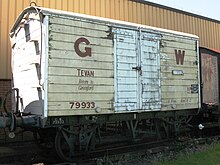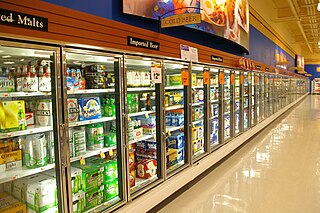
Refrigeration is any of various types of cooling of a space, substance, or system to lower and/or maintain its temperature below the ambient one. Refrigeration is an artificial, or human-made, cooling method.
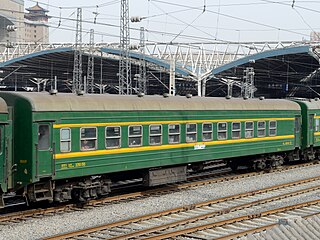
A railroad car, railcar, railway wagon, railway carriage, railway truck, railwagon, railcarriage or railtruck, also called a train car, train wagon, train carriage or train truck, is a vehicle used for the carrying of cargo or passengers on a rail transport network. Such cars, when coupled together and hauled by one or more locomotives, form a train. Alternatively, some passenger cars are self-propelled in which case they may be either single railcars or make up multiple units.
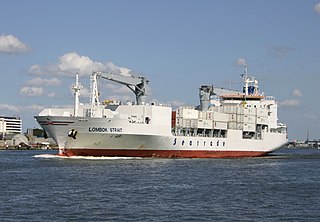
A reefer ship is a refrigerated cargo ship typically used to transport perishable cargo, which require temperature-controlled handling, such as fruits, meat, vegetables, dairy products, and similar items.

In railroad terminology, a stock car or cattle car is a type of rolling stock used for carrying livestock to market. A traditional stock car resembles a boxcar with louvered instead of solid car sides for the purpose of providing ventilation; stock cars can be single-level for large animals such as cattle or horses, or they can have two or three levels for smaller animals such as sheep, pigs, and poultry. Specialized types of stock cars have been built to haul live fish and shellfish and circus animals such as camels and elephants. Until the 1880s, when the Mather Stock Car Company and others introduced "more humane" stock cars, death rates could be quite high as the animals were hauled over long distances. Improved technology and faster shipping times have greatly reduced deaths.

In United States railroad terminology, a troop sleeper was a railroad passenger car which had been constructed to serve as something of a mobile barracks for transporting troops over distances sufficient to require overnight accommodations. This method allowed part of the trip to be made overnight, reducing the amount of transit time required and increasing travel efficiency.

"Juice Train" is the popular name for unit trains of Tropicana fresh orange juice operated by railroads in the United States.

Gustavus Franklin Swift, Sr. was an American business executive. He founded a meat-packing empire in the Midwest during the late 19th century, over which he presided until his death. He is credited with the development of the first practical ice-cooled railroad car, which allowed his company to ship dressed meats to all parts of the country and abroad, ushering in the "era of cheap beef." Swift pioneered the use of animal by-products for the manufacture of soap, glue, fertilizer, various types of sundries, and even medical products.
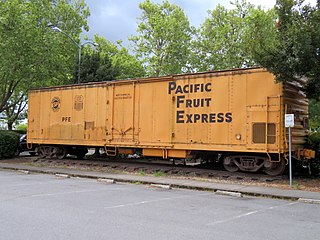
Pacific Fruit Express was an American railroad refrigerator car leasing company that at one point was the largest refrigerator car operator in the world.

An icebox is a compact non-mechanical refrigerator which was a common early-twentieth-century kitchen appliance before the development of safely powered refrigeration devices. Before the development of electric refrigerators, iceboxes were referred to by the public as "refrigerators". Only after the invention of the modern electric refrigerator did early non-electric refrigerators become known as iceboxes. The terms ice box and refrigerator were used interchangeably in advertising as long ago as 1848.
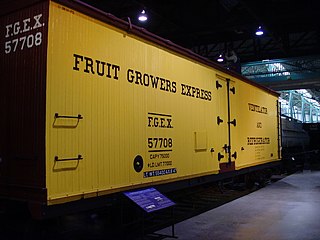
Fruit Growers Express (FGE) was a railroad refrigerator car leasing company that began as a produce-hauling subsidiary of Armour and Company's private refrigerator car line. Armour controlled both the packing operations and the transport insulated railroad car line, and its customers had complained they were overcharged. In 1919 the Federal Trade Commission ordered the company's spinoff of Fruit Growers Express for antitrust reasons, which was accomplished by 1920.

An icemaker, ice generator, or ice machine may refer to either a consumer device for making ice, found inside a home freezer; a stand-alone appliance for making ice, or an industrial machine for making ice on a large scale. The term "ice machine" usually refers to the stand-alone appliance.
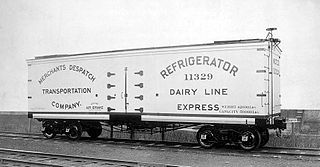
The Merchants Despatch Transportation Company was established in 1857 or 1858 by the American Express Company of New York. The entity was reformed as a joint stock trading company on June 1, 1869, with ownership divided among the Cleveland, Columbus, Cincinnati and Indianapolis Railway (CCC&I), the Lake Shore and Michigan Southern Railway, and the New York Central Railroad (NYC), all part of the Cornelius Vanderbilt rail empire.
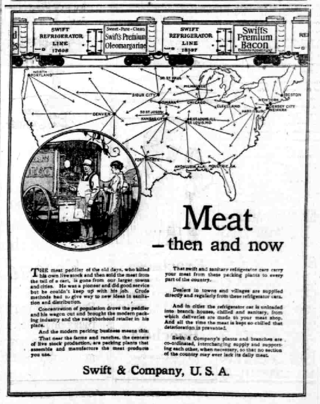
The Swift Refrigerator Line was a private refrigerator car line established around 1875 by Chicago meat packer Gustavus Swift, the founder of Swift and Company.

Two distinct and separate railroad refrigerator car companies have operated under the name Western Refrigerator Line.
Milk cars are a specialized type of railroad car intended to transport raw milk from collection points near dairy farms to a processing creamery. Some milk cars were intended for loading with multiple cans of milk, while others were designed with a single tank for bulk loading. Milk cars were often equipped with high-speed passenger trucks, passenger-type buffer plates, and train signal and steam lines seldom found on conventional refrigerator cars.

A refrigerated container or reefer is an intermodal container used in intermodal freight transport that is capable of refrigeration for the transportation of temperature-sensitive, perishable cargo such as fruits, vegetables, meat, fish, seafood, and other similar items.

A refrigerator truck or chiller lorry, is a van or truck designed to carry perishable freight at low temperatures. Most long-distance refrigerated transport by truck is done in articulated trucks pulling refrigerated hardside (box) semi-trailers, although insulated curtainsiders are common in some countries. Occasionally, refrigerated trailers have been used as temporary morgues, and second-hand refrigerated trailers are frequently sold for use in tiny home conversions due to their insulation and existing status as a vehicle.

A refrigerated van is a railway goods wagon with cooling equipment. Today they are designated by the International Union of Railways (UIC) as Class I.
This article lists some of the terminology used at present and in the past by railway employees, railway enthusiasts and railway historians in Australia. Many appear from time to time in specialist, rail-related publications. Significant regional variations exist, indicated by abbreviations of the state or railway.
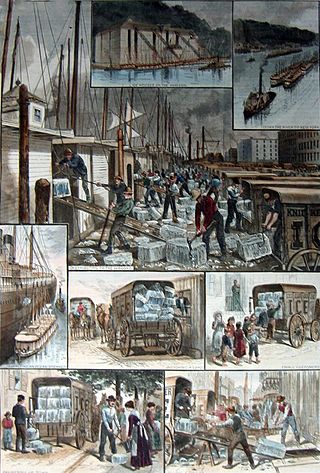
The ice trade, also known as the frozen water trade, was a 19th-century and early 20th-century industry, centering on the east coast of the United States and Norway, involving the large-scale harvesting, transport and sale of natural ice, and later the making and sale of artificial ice, for domestic consumption and commercial purposes. Ice was cut from the surface of ponds and streams, then stored in ice houses, before being sent on by ship, barge or railroad to its final destination around the world.

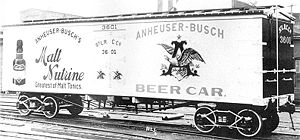
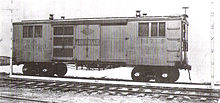
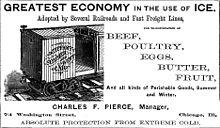







![A JNR ReMu 5000 type [ja] refrigerator car at Amagasaki Station, June 1984 JNR FC remu5465.jpg](http://upload.wikimedia.org/wikipedia/commons/thumb/5/57/JNR_FC_remu5465.jpg/220px-JNR_FC_remu5465.jpg)

